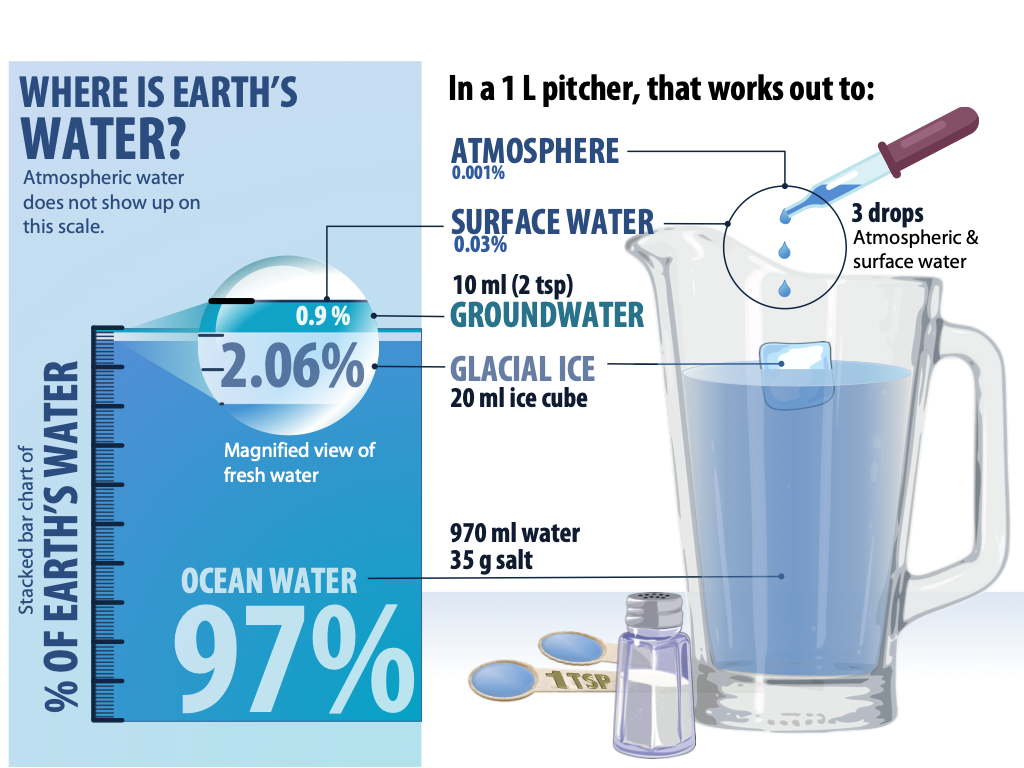14.1 Streams in the Hydrological Cycle
The Hydrological Cycle
Water is constantly on the move. It is evaporated from the oceans, lakes, streams, the surface of the land, and from plants (transpiration) by solar energy (Figure 14.2). It’s transported in its gaseous form through the atmosphere by the wind and condenses to form clouds of water droplets or ice crystals. It falls to the Earth’s surface as precipitation (rain or snow) and flows through streams, into lakes, and eventually back to the oceans. Water on the surface and in streams and lakes seeps into the ground—or infiltrates—to become groundwater. Groundwater slowly moves through soils, surficial materials, and gaps and cracks in the rock. The groundwater can then re-emerge on the surface, and move back into streams, lakes and oceans.
![The various components of the water cycle. Black or white text indicates the movement or transfer of water from one reservoir to another. Yellow text indicates the storage of water. [SE after Ingwik CC-BY-SA http://bit.ly/HydCyc]](https://pressbooks.bccampus.ca/physicalgeologyh5p/wp-content/uploads/sites/1304/2017/05/water-cycle-1024x599.png)
Water is stored in various reservoirs as it moves across and through the Earth. A reservoir is a space that stores water. It can be a space we can easily visualize (such as a lake) or a space that’s more difficult to visualize, such as the atmosphere or the groundwater in a region. The largest reservoir is the ocean, accounting for 97% of the total volume of water on Earth (Figure 14.3, left). Ocean water is salty, but the remaining 3% of water on Earth is fresh water. Two-thirds of our fresh water is stored in the ground and one-third is stored in ice. The remaining fresh water (about 0.03% of the total) is stored in lakes, streams, vegetation, and the atmosphere.

To put these percentages in perspective, we can compare a 1 litre container of water to the entirety of the Earth’s water supply (Figure 14.3, right). We start by almost filling the container with 970 ml of water and 34 g of salt, to simulate all the sea water on Earth. Then we add one regular-sized (~20 ml) ice cube to represent glacial ice and two teaspoons (~10 ml) of groundwater. All of the water that we see around us in lakes and streams and in the atmosphere can be represented by adding three more drops of water from an eyedropper.
Although the water in the atmosphere is only a small proportion of the total water on Earth, the volume is still very large. At any given time, there is the equivalent of approximately 13,000 km3 of water in the air in the form of water vapour and water droplets in clouds. Water is evaporated from the oceans, vegetation, and lakes at a rate of 1,580 km3 per day, and each day nearly the same volume falls back as rain and snow over the oceans and land. Most of the precipitation that falls onto land returns to the ocean in the form of stream flow (117 km3/day) and groundwater flow (6 km3/day). Most of the rest of this chapter is about this 117 km3/day of streamflow.
How Long Does Water Stay in the Atmosphere and Ocean?
Runoff Pathways are Where Streams Get Their Water
Surface water from precipitation, called runoff, can enter streams in a number of ways. Channel precipitation occurs when water enters a stream by falling directly into it.
Streams get water from the process that begins with infiltration, when runoff seeps into the ground, and becomes groundwater. Groundwater water exists in pore spaces such as gaps between grains in sediments and rocks, or in other cracks or gaps in rocks (Figure 14.4). If the channel is below the water table—the surface below which all of the pores and crevices are filled with water—then the groundwater will flow into the channel.

Overland flow occurs when infiltration cannot take place, such as when the ground is already saturated (all pores are filled), and water flows over the land surface and into a stream.
Perennial versus Ephemeral Streams
Streams are able to flow all year round when there is sufficient runoff to offset evaporation and water use. These are called perennial streams (or sometimes permanent streams). Streams that flow only part of the year are ephemeral streams.
Whether or not a stream is perennial will depend in part on whether the climate is dry or humid, and also on the elevation of the water table relative to the channel. If the water table is consistently higher than the channel (Figure 14.5, left), this will supply the stream year-round. In a dry climate, streams may only flow during a rainy time of year, or during spring melts. If the water table is below the stream channel (Figure 14.5, right), then the stream will always be losing water to infiltration.

Perennial streams fed by groundwater can become ephemeral streams or dry up altogether if the water table drops below the channel. The water table can drop if humans extract groundwater faster than it is recharged by infiltration.
A consequence of a drop in the water table is that sediment grains previously held apart by water can be pushed together by the weight of overlying sediments, reducing the spaces between the grains. The spaces can’t be opened again. This has a number effects: one is that the sediments can’t hold as much water as they did before, reducing the amount of groundwater that can be stored in the future. The other effect is subsidence, a decrease in the height of the land surface that reflects the grains moving closer together. Yet another is that the infiltration rate during heavy precipitation events will decrease (because water can’t get into the pore spaces as fast, or else the pore spaces fill up more rapidly). Water that can’t escape into the ground will flow over the land surface.

